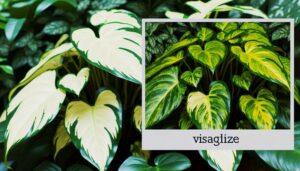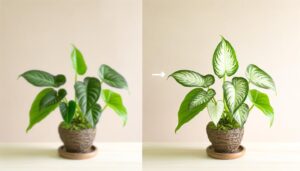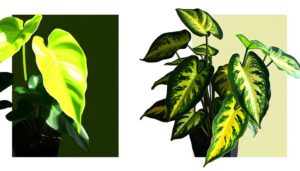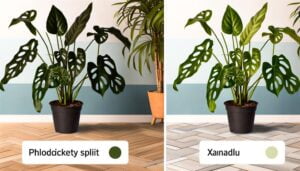Philodendron Gloriosum Vs Zebra: Key Differences!
The Philodendron Gloriosum and Zebra Plant (Aphelandra squarrosa) exhibit distinct characteristics. Philodendron Gloriosum has large, velvety, heart-shaped leaves with prominent white veins, providing a lush tropical aesthetic.
Conversely, Aphelandra squarrosa features smaller, ovate, glossy leaves with white or yellow zebra-like stripes, offering a compact ornamental appeal. Both thrive in bright, indirect light but differ in watering needs; Gloriosum prefers watering when the top inch of soil is dry, while Zebra plants require more consistent moisture.
Soil requirements also vary, with the Gloriosum favoring well-draining aroid mixes and Zebra plants preferring slightly acidic substrates. To understand their care in detail, more information is available.

Comparison of Philodendron Gloriosum and Philodendron Gloriosum ‘Zebra’
| Feature | Philodendron Gloriosum | Philodendron Gloriosum ‘Zebra’ |
|---|---|---|
| Leaf Color | Bright green with white veins | Green with more prominent striped veining |
| Leaf Pattern | Standard vein pattern | More pronounced zebra-like striping |
| Stem Shape | Typically D-shaped | Round (according to one source) |
| Rarity | Relatively common in cultivation | Rarer, considered a special variant |
| Care Requirements | Standard Gloriosum care | Similar to standard Gloriosum |
| Growth Habit | Terrestrial, crawling | Terrestrial, crawling |
| Origin | Natural species | Likely a cultivar or natural variation |
Appearance and Foliage
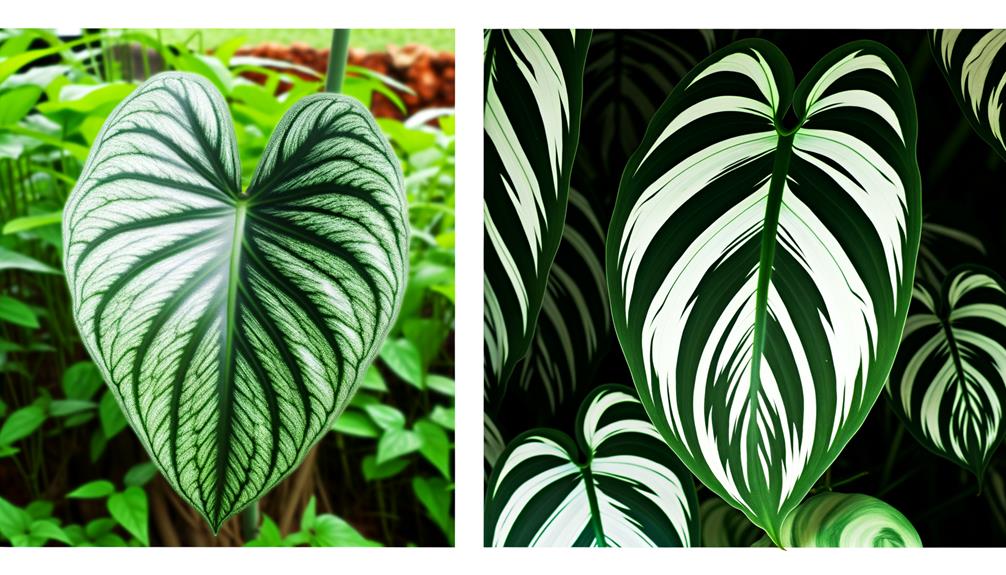
When comparing the appearance and foliage of Philodendron Gloriosum and Zebra plants, it is essential to examine their distinct morphological characteristics and leaf structures.
Philodendron Gloriosum features large, heart-shaped, velvety leaves with prominent white veins, creating a striking contrast against its deep green hue. The leaves are typically expansive, contributing to its lush and tropical aesthetic.
In contrast, Zebra plants, specifically Aphelandra squarrosa, boast smaller, ovate leaves with a glossy texture. Their foliage is characterized by distinctive white or yellow veins that form a striking pattern against the dark green background. This veining pattern resembles zebra stripes, hence the name.
The overall appearance of Zebra plants is more compact and structured, presenting a visually orderly and ornamental appeal.
Light Requirements
Evaluating the light needs of Philodendron Gloriosum and Zebra plants reveals significant differences that impact their best growth environments. Philodendron Gloriosum thrives in bright, indirect light, replicating the dappled sunlight of its native tropical understory.
Conversely, Zebra plants (Aphelandra squarrosa) require medium to bright indirect light, but too much direct sunlight can cause leaf burn. Optimal light conditions for both species are essential for their physiological processes, including photosynthesis and growth.
| Aspect | Philodendron Gloriosum | Zebra Plant (Aphelandra squarrosa) |
|---|---|---|
| Native Habitat Light | Dappled shade | Tropical understory |
| Optimal Light Intensity | Bright, indirect | Medium to bright indirect |
| Tolerance to Direct Light | Low | Low |
| Response to Low Light | Slower growth, leggy appearance | Reduced flowering |
| Ideal Placement Indoors | Near east or north-facing window | Near east or north-facing window |
Understanding these distinctions guarantees proper placement and care for each plant.
Watering Needs

In addition to their unique light needs, the watering requirements of Philodendron Gloriosum and Zebra plants (Aphelandra squarrosa) also differ significantly, impacting their overall health and growth patterns.
Philodendron Gloriosum thrives in consistently moist but not waterlogged soil, requiring a balanced watering schedule. In contrast, Aphelandra squarrosa requires more frequent watering due to its higher transpiration rate and preference for slightly more humid conditions.
Here are their key watering preferences:
- Philodendron Gloriosum: Water when the top inch of soil is dry.
- Aphelandra squarrosa: Maintain consistent soil moisture; do not let it dry out completely.
- Philodendron Gloriosum: Use room-temperature water to prevent root shock.
- Aphelandra squarrosa: Ensure proper drainage to prevent root rot.
Understanding these subtle needs ensures essential plant health.
Soil and Potting
Proper soil composition and potting techniques are essential for the best growth of both Philodendron Gloriosum and Zebra plants. Each species requires specific conditions to thrive.
Philodendron Gloriosum favors a well-draining, aroid-specific soil mix. This mix is typically made up of peat, perlite, and orchid bark, ensuring aeration and moisture retention.
Conversely, Zebra plants (Aphelandra squarrosa) require a slightly acidic, moisture-retentive substrate. This substrate often consists of peat moss, garden soil, and sand for prime drainage and pH balance.
When potting, Philodendron Gloriosum benefits from wide, shallow containers that accommodate their creeping rhizomes. On the other hand, Zebra plants thrive in standard, well-draining pots.
The differential requirements emphasize the importance of tailored soil and potting strategies for each plant species’ best health and development.
Growth and Maintenance
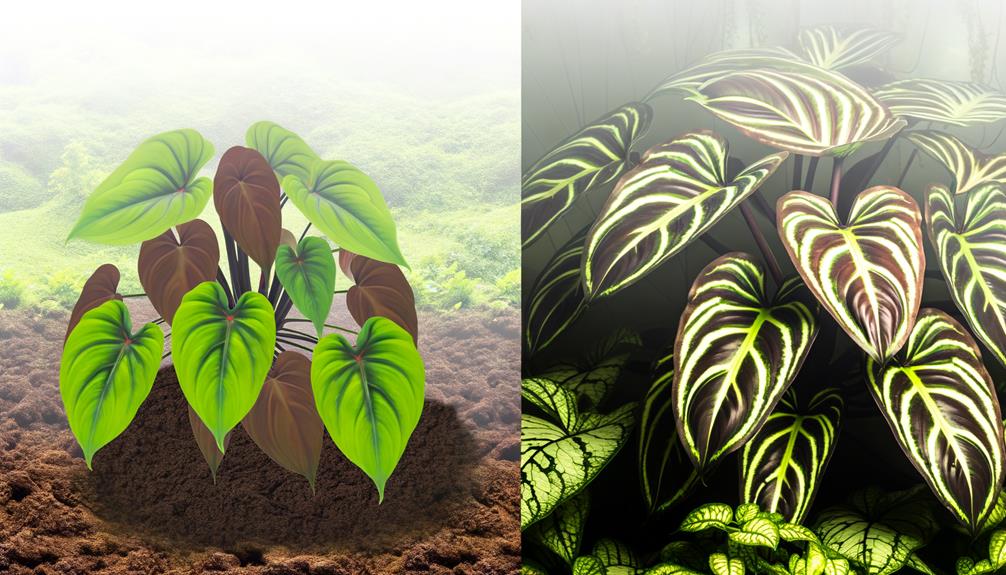
Ensuring ideal growth and maintenance for Philodendron Gloriosum and Zebra plants involves understanding their distinct light, water, and nutrient requirements, as well as implementing appropriate pruning and pest control measures.
Philodendron Gloriosum thrives in bright, indirect light and requires consistent moisture, while Zebra plants (Aphelandra squarrosa) prefer moderate to high humidity with partial shade.
Comparative analysis reveals:
- Watering Frequency: Philodendron Gloriosum needs watering when the top inch of soil is dry, whereas Zebra plants require more frequent watering to maintain moist soil.
- Nutrient Needs: Both benefit from balanced, slow-release fertilizers, but the Zebra plant may need additional micronutrients.
- Pruning: Prune dead or yellowing leaves regularly to promote new growth.
- Pest Control: Inspect for common pests like spider mites and aphids, using neem oil as a natural remedy.
Conclusion
In the comparative analysis of Philodendron gloriosum and Zebra plants, intriguing distinctions emerge across multiple dimensions.
Appearance and foliage display unique characteristics, while light requirements and watering needs diverge notably.
Soil preferences and potting techniques further differentiate their cultivation.
Growth and maintenance practices reveal varying complexities.
Which will thrive in specific conditions? The answer lies in understanding each plant’s demands and adapting to their distinct ecological niches, thereby ensuring best growth and aesthetic satisfaction.

